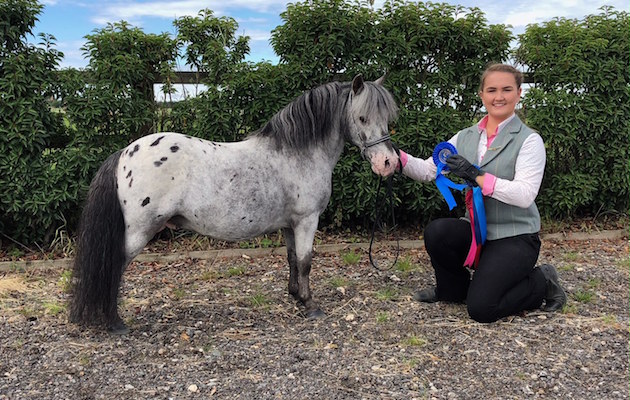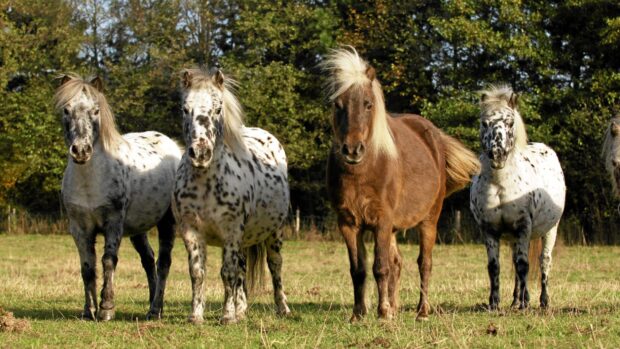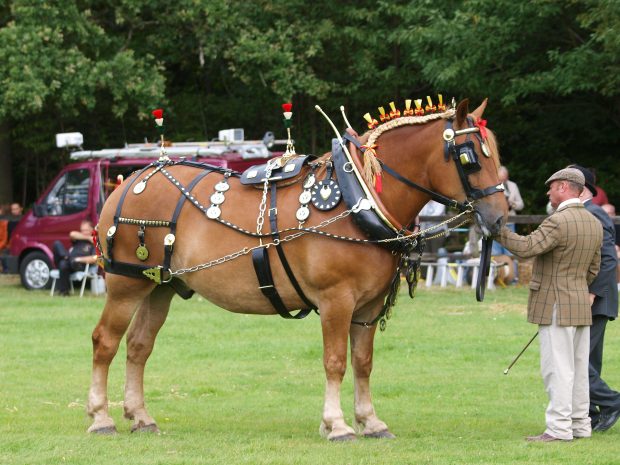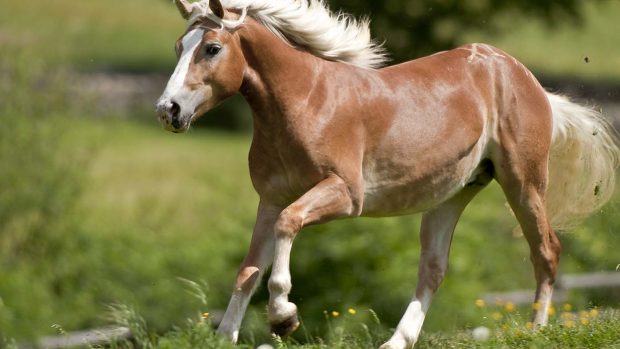A miniature horse should be just that – a mini, in-proportion version of a quality riding horse. Often labelled by those not in the know as a “little pony” or a Shetland, a miniature horse is neither (although many would have Shetland in their ancestry). It should show the same conformation and movement as you’d want in full-size horse. While the smaller pony breeds tend to be stockier and proportionally shorter-legged than horses, a miniature horse should have a certain elegance about its diminutive stature. They have longer necks and legs relative to their size than ponies of the same height.
Cute, dinky and typically trainable, miniature horses are sometimes seen as a good pet for those who have sufficient outdoor space. However, despite being not much bigger than a large dog, they have the same needs as regular horses and flourish when given appropriate field space to graze and roam, although they can be trained to work indoors, such as for therapy, visiting hospices, pantomimes and so on.
In this article: What is a miniature horse | History | Uses

An adorable mare and foal in their winter coats
How to define a miniature horse
There are a number of societies which have their own sets of rules on the miniature horse. The main criteria to define a miniature is its height (typically measured in inches rather than hands), and even on this the societies differ. The American Miniature Horse Association and British Miniature Horse Society (BMHS) state that 34 inches (8.2hh)is the maximum height, while the American Miniature Horse Registry allows up to 38 inches (9.2hh).
The BMHS was founded in 1992 to promote the welfare, breeding and showing of miniature horses – and has since become a studbook and passport issuing organisation. The BMHS describes miniature horses as “while not a specific breed, they should be similar in type to a hack or hunter” , and should “never be pony-like”.
The AMHA has a breed standard, with the goal being to “produce the smallest possible perfect horse”:
- Temperament: intelligent, curious, gentle, sensible, willing to cooperate and train
- Size: not exceeding 34 inches
- Colour: any coat colour, pattern, white markings and eye colour are acceptable
- Head: beautiful, triangular in shape, small in comparison to length of neck and body. Large, prominent eyes, set well apart. Profile may be straight of slightly dished. Refined muzzle with large nostrils. Ears should be medium sized, with pointed tips curving inwards
- Neck and shoulders: neck should be slender and slightly arched with good topline. Set on a well-angulated shoulder allowing for a free-swinging stride
- Body: compact with short back, well-muscled croup and well-set tail
- Legs: should appear longer than the body is deep. Overall impression of refinement and athleticism
Potted history of the miniature horse
The miniature horse goes back to the Renaissance, and has evolved over the centuries as a blend of selected breeds to become the tiny, elegant animal we see today. Back in the 17th century, miniature horses were popular among both princes and paupers. They were kept as pets for the aristocracy, playthings for palace children – especially in the realm of Louis XIV in France. But they were also used in coal mines where their size and relative strength was ideal in the constricted space, and travelling circuses.
A miniature horse owes its form to many different breeds. The Argentine Falabella is the first and original miniature horse breed, which descends from Andalusian, Spanish Barbs and Criollos. The Falabella was established in the mid-19th century by constantly breeding from the smallest and finest quality of each generation. Nowadays, Falabellas have Arabian, thoroughbred, quarter horse, pinto and appaloosa in their bloodlines.
The European miniature horses originally had plenty of Shetland blood, as well as Hackney, Welsh pony, Arab and thoroughbred, and have been bred over centuries to produce these tiny horses that give so much joy today.
What are miniature horses used for today
Miniature horses are increasingly popular as therapy animals, visiting schools and hospices. Due to their smaller size, they tend to be less intimidating to those unfamiliar with horses, easy to handle, and undeniably cute.
They are generally too small to be ridden except by very lightweight children – and the problem comes with how to back them. They typically weigh 10 to 25 stone, and the consensus is that even the larger horses should not carry more than five stone. This follows the guidance that a horse should carry a maximum of 20% of its own weight.
However, they provide huge enjoyment for competitive owners in the show ring, contesting classes from local shows right up to Royal International and Horse of the Year Show.

Scott Creek Monarch Red Graffiti, a supreme miniature horse champion at the Royal International Horse Show
Like all equines, miniature horses prefer to live in company with other horses, and as such can make good companions and pets. However, in common with many ponies, their diets must be controlled to prevent obesity and related diseases, but they do have long life expectancy – typically 25–30 years. And as with all pets, they thrive in a knowledgable and loving home.
In terms of cost, just as they are a scaled-down version of a horse, their price-tag is proportionally smaller. A quality stallion with RIHS qualifications might cost around £5,000, while less experienced horses would go for £1,500. But as with any horse, prices are dependent on age, pedigree, training, temperament, conformation, ability and market rates.
You may also like to read…

Miniature horses: the veterinary issues you should know about
Miniature horses may be dwarfed by their full-sized counterparts, but health issues can still loom large — as Lesley Barwise-Munro

Miniature marvel to lead Queen’s horses parade
The theme of the 2019 New Year’s Day parade is ‘London welcomes the world’

The Shetland pony: a small, strong pony that can pull twice its own bodyweight
Discover more about this small, hardy breed of pony

Subscribe to Horse & Hound magazine today – and enjoy unlimited website access all year round
Horse & Hound magazine, out every Thursday, is packed with all the latest news and reports, as well as interviews, specials, nostalgia, vet and training advice. Find how you can enjoy the magazine delivered to your door every week, plus options to upgrade your subscription to access our online service that brings you breaking news and reports as well as other benefits.




